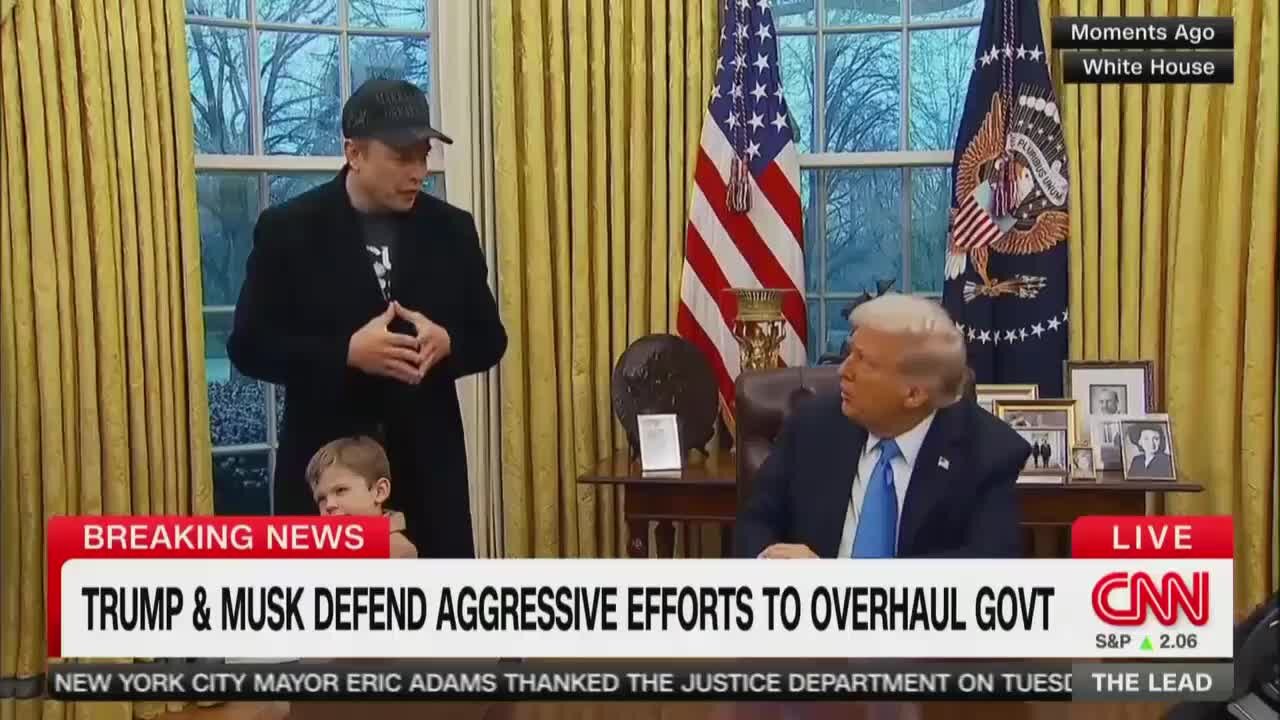Premium Only Content

Elon Musk Explains DOGE’s Work in Oval Office Address: ‘There’s a Limestone Mine!’
Trump: “— things that your team has found, some of the crazy numbers, including the woman that walked away with about $30 million, etc.”
Musk: “Right. Well, we do find it sort of rather odd that, you know, there are quite a few people in actually here who have ostensibly a salary of a few hundred thousand dollars, but somehow managed to accrue tens of millions of dollars in net worth while they are in that position, which is, you know, what happened to USAID, which we’re just curious as to where it came from. Maybe they are very good at investing, in which case we should take their investment advice perhaps. But it just seems to be mysteriously that they get wealthy. We don’t know why. Where does it come from? And I think the reality is that they’re getting wealthy at taxpayer expense. That’s the honest truth of it. So, you know, we’re looking at, say, well, just if you look at, say Treasury, for example, basic controls that should be in place, that are in place in any company, such as making sure that any given payment has a payment categorization code, that there is a comment field that describes the payment. And that if a payment is on the ‘do not pay’ list, that you don’t actually pay it. None of those things are true currently. So the reason that departments can’t pass audits is because the payments don’t have a categorization code. It’s like just a massive number of blank checks, just plain not moving. So you can’t reconcile blank checks. You’ve got comment fields that are also blanks. So, you don’t know why the payment was made. And then we’ve got this truly absurd, a ‘do not pay’ list, which can take up to a year for an organization to get on a ‘do not pay’ list. And this, we’re talking about terrorist organizations. We’re talking about known fraudsters. Know aspects of waste. Known things that do not match any congressional appropriation can take up to a year to get on the list. And even once on the list, the list is not used. It’s mind-blowing. So what we’re talking about here, we’re really just talking about adding common sense controls that should be present, that haven’t been present. So you say like, well, how could such a thing arise? That seems — that seems crazy that when you understand it, that really everything is geared towards complaint minimization. So then you understand the motivations. So if people receive money, they don’t complain, obviously. But if people don’t receive money, they do complain and the fraudsters complain the loudest and the fastest. So then when you understand that, then it makes sense. That’s why everything just — they approve all the payments at Treasury. Because if you approve all the payments, you know, you don’t get complaints. But now — now we’re saying that no, actually, we are going to complain if money is spent badly. If your taxpayer dollars are not spent in a sensible and frugal manner, then that’s not okay. Your tax dollars need to be spent wisely on the things that matter to the people. I mean, these things, like, it’s just common sense. It’s not — it’s not draconian or radical, I think. It’s really just saying let’s look at each of the expenditures and say, is this actually in the best interest of the people? And if it is, it’s approved. If it’s not, we should think about it. So, you know, there’s crazy things, like, just cursory examination of Social Security. And we’ve got people in there that are 150 years old. Now, do you know anyone who’s 150? I don’t. Okay. They should be on the Guinness Book of World Records. They’re missing out. So, you know, that’s a case where, like, I think they’re probably dead. That’s my guess. Or they should be very famous. One of the two. And then there’s a whole bunch of Social Security payments where there’s no identifying information. Like, why is there no identifying information? Obviously, we want to make — we want to make sure that people who deserve to receive Social Security do receive it and receive it quickly and accurately. Also, another crazy thing. So, you know, one of things is like, we are trying to sort of rightsize the federal bureaucracy to just make sure that this — obviously, there need to be a lot of people working for the federal government, but not as many as currently. So we’re saying, well, okay, well, it’s — if people can retire, you know, with full benefits, everything, that would be good. They can retire, get their retirement payments, everything. And then, we’re told, this is actually, I think, a great anecdote because we’re told that the most number of people that could retire possibly in a month is 10,000. We’re like, well, why is that? Well, because all that — all the retirement paperwork is manual on paper. It’s manually calculated. They’re written down on a piece of paper. Then it goes down a mine and like, what do you mean a mine? Like, yeah, there’s a limestone mine where we store all the retirement paperwork. And you look at a picture, we will post some pictures afterwards. And this is — this mine looks like something out of the ‘50s because it was started in 1955. So it looks like, it’s like a time warp. And then the speed, the limiting factor is the speed at which the mine shaft elevator can move, determines how many people can retire from the federal government. And the elevator breaks down sometimes and then nobody can retire.”
-
 0:46
0:46
Grabien
10 hours agoTrump: Zelenskyy Is in a ‘Tough Situation,’ ‘Fighting a Much Bigger Force’
16 -
 1:24:54
1:24:54
Badlands Media
9 hours agoBaseless Conspiracies Ep. 130
34.4K10 -
 LIVE
LIVE
FreshandFit
2 hours agoModern Men VS Modern Women
1,958 watching -
 LIVE
LIVE
vivafrei
4 hours agoELECTIONS CANADA RESULTS LIVE STREAM WITH VIVA COMMENTARY!!!
5,728 watching -
 2:39:37
2:39:37
TimcastIRL
4 hours agoDemocrat LAUNCHES IMPEACHMENT Against Trump Citing Deportation, Abrego Garcia Case | Timcast IRL
116K114 -
 2:17:27
2:17:27
IcyFPS
2 hours agoA new legend rises.. Icy vs Teardrop | @playoffthegrid | Team MERC Grind |
4371 -
 LIVE
LIVE
TwinGatz
4 hours ago🔴LIVE - Endless Jank | Oblivion Remastered
76 watching -
 1:33:55
1:33:55
Glenn Greenwald
9 hours agoGaza Starves, Pro-Israel Propagandists Escalate Extremist Rhetoric and Actions | System Update #444
110K254 -
 LIVE
LIVE
EnDuEnDo
4 hours ago🚨Variety Stream 🎮 Push to 500 Followers 🚀 Chill Vibes 😎
79 watching -
 11:04:48
11:04:48
GrimmHollywood
12 hours ago🔴LIVE • GRIMM HOLLYWOOD • SHADOW OF THE ERDTREE FIRST PLAYTHROUGH • PART 1
43.6K2